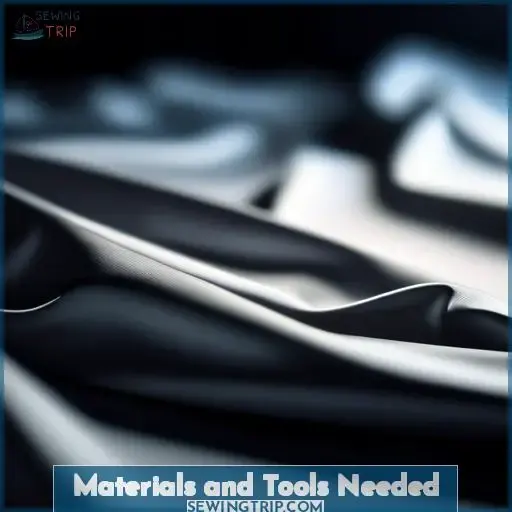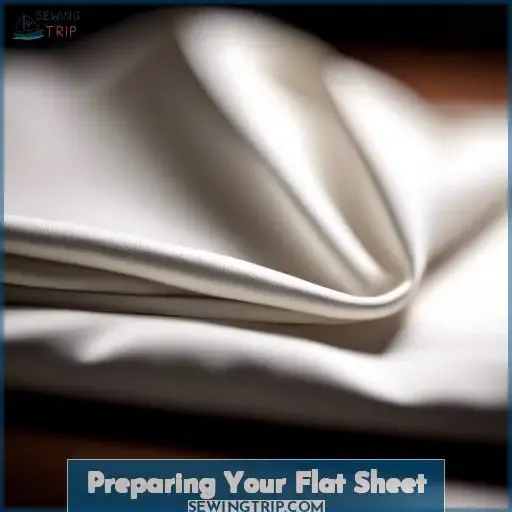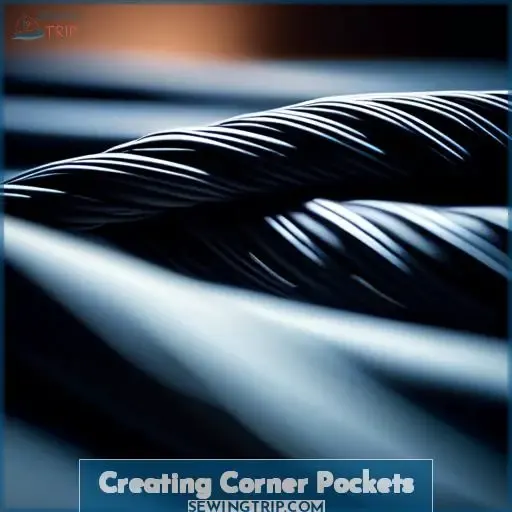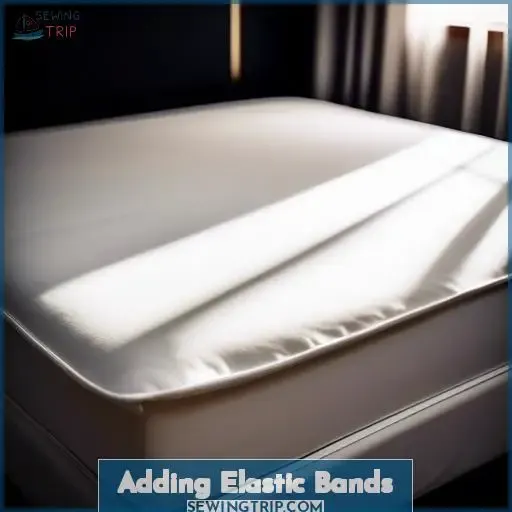This site is supported by our readers. We may earn a commission, at no cost to you, if you purchase through links.
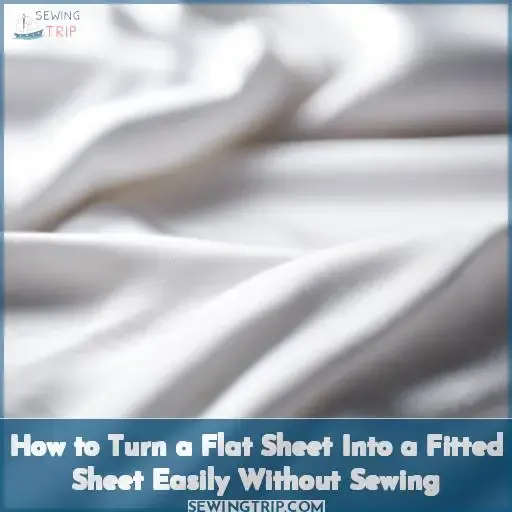 Transforming a flat sheet into a fitted sheet without sewing might sound like a crafty challenge, but it’s actually a straightforward process that can give your bedding a custom fit and feel.
Transforming a flat sheet into a fitted sheet without sewing might sound like a crafty challenge, but it’s actually a straightforward process that can give your bedding a custom fit and feel.
This guide will walk you through the steps to easily convert your flat sheets, using simple materials and techniques. Perfect for those who value innovation and practical solutions, you’ll discover how to create snug, perfectly fitted sheets that stay put, enhancing your comfort and sleep experience.
Table Of Contents
Key Takeaways
- Measure the mattress dimensions accurately to ensure the flat sheet will cover the entire mattress once converted into a fitted sheet.
- Mark and cut the corners of the flat sheet to create fabric pockets, which will help secure the sheet to the mattress corners.
- Use sturdy elastic bands to create tension around the edges of the sheet, allowing it to snugly fit around the mattress without slipping.
- Distribute the elastic stretch evenly around the perimeter of the sheet to avoid overstretching or bunching, ensuring a smooth fit on the mattress.
How to Turn a Flat Sheet Into a Fitted Sheet Without Sewing

To turn a flat sheet into a fitted sheet without sewing, you can use methods like folding and tucking under the mattress or using clips and straps to secure the sheet in place.
Materials and Tools Needed
Ready to transform that flat sheet into a snazzy fitted one without the fuss of sewing? You’ll need to grab a few essentials first.
Ensure you’ve got a flat sheet that’s generous in size for your mattress depth—think of it as your canvas.
Now, let’s talk elastic bands. You’ll want a sturdy type that can take a good stretch without waving the white flag. If you’re feeling fancy, a sewing machine can speed things up, but if you’re all about that hands-on approach, your trusty fingers will do.
Fold, measure, and tailor that sheet with a dash of creativity, and you’ll have a fitted masterpiece in no time.
Preparing Your Flat Sheet
To start transforming your flat sheet into a fitted one, you’ll first need to measure your mattress accurately. Marking the corners is your next crucial step, ensuring a snug fit without any sewing required.
Measuring Your Mattress
Before diving into the transformation of your flat sheets, grab your tape measure and cozy up to your mattress.
This isn’t just about numbers; it’s about ensuring your DIY project fits like a glove. Think of it as matchmaking between your fabric choice and your bed’s corner shape. This initial step is crucial for achieving that snug fit and DIY satisfaction, setting the stage for the magic of elastic tension to work its wonders.
Marking the Corners
After measuring your mattress, it’s time to dive into corner marking.
Think of it as mapping your treasure hunt—where X marks the spot.
With precise measurements in hand, ensure you’ve got enough fabric to play with.
This step is crucial for avoiding durability woes later on.
It’s like cutting your twin bed sheet with design guides, not just winging it.
Creating Corner Pockets
Transforming your flat sheet into a fitted one without sewing begins with creating corner pockets. You’ll cut and fold the fabric, securing it with pins to form the essential shape.
Cutting the Corners
After measuring your mattress, it’s time to dive into cutting those corner shapes.
Think of it as tailoring your flat sheet’s very own Cinderella slipper—no fairy godmother required.
Grab your scissors and cut where you’ve marked, keeping in mind the fabric types and how they fray.
This step is crucial for a snug fit, turning dreams of no-sew fitted sheets into reality.
Folding and Pinning
After cutting your corners, it’s time to dive into folding and pinning, a crucial step in transforming your flat sheet into a snug fitted one without a stitch in sight.
Focus on pin precision and corner alignment to ensure your fabric choice hugs each corner with just the right elastic tension. This method not only reinforces your corners but also keeps your sheet firmly in place, marrying innovation with simplicity.
Adding Elastic Bands
Now that you’ve crafted the corner pockets with finesse, it’s time to give your sheet the snug embrace of a fitted one. Adding elastic bands is like giving your bed a hug that keeps the covers tight and just right.
- Measure the elastic for durability, ensuring it’s slightly shorter than the pocket’s perimeter for that snug fit.
- Sew or knot the elastic replacement into place, creating a tension that’s taut but not overbearing.
- Distribute the elastic stretch evenly, avoiding any unwanted gathering or bunching.
Final Adjustments and Fitting
Once you’ve added the elastic bands to your flat sheet, it’s time to test it on your mattress. This step ensures a snug fit and offers additional tips for perfecting the conversion.
Testing on Mattress
Once you’ve added the elastic bands, it’s showtime! Stretch your newly fitted sheet over the mattress and check the fit. You’re aiming for a snug embrace without the elastic throwing a tantrum. If the corners seem to play peek-a-boo, reinforce them for a lasting fit.
| Aspect | Checkpoint |
|---|---|
| Elastic Tightness | Should hug corners without overstretching |
| Corner Reinforcement | Peek-a-boo corners? Time for a fabric fort |
| Fabric Durability | No signs of surrender under tension |
| Cost Comparison | Smug savings smile compared to store-bought |
| Comfort Level | Like a hug from your mattress |
Additional Tips for a Perfect Fit
Once you’ve wrestled your flat sheet onto the mattress, give it a good tug here and there to see how the fabric stretch behaves.
If the corners seem rebellious, consider reinforcing them to keep that elastic tension in check.
Master the art of tucking with finesse to complement your mattress’s unique shape.
It’s like giving your bed a custom-fit suit—snazzy and snug!
Frequently Asked Questions (FAQs)
Can I use any type of fabric for this?
Sure, you can use any fabric, but remember, stretchy materials like knits might give you a snugger fit without sewing than stiffer fabrics like canvas would.
How long does the elastic band need to be?
You’ll need elastic that’s about ⅔ the total length of your sheet’s perimeter. So, grab your tape measure, do a quick calculation, and cut that elastic.
What’s the best way to measure mattress depth?
To measure your mattress depth, grab a tape measure, start at the bottom edge, and extend it to the top, including any toppers.
Can this method be used for non-standard mattress sizes?
Like a chameleon adapts to its environment, you can transform any flat sheet to snugly fit non-standard mattress sizes, ensuring your sleep haven remains an oasis of comfort and innovation.
How do I care for my converted fitted sheet?
Caring for your DIY fitted sheet’s a breeze. Wash it in cool water, tumble dry on low, and give it a quick stretch before popping it back on.
Conclusion
Surprisingly, 27% of sleepers report discomfort due to ill-fitting sheets.
But with this guide, you’ve learned how to turn a flat sheet into a fitted sheet without sewing, ensuring a snug bed that invites restful sleep.
You’ve mastered creating corner pockets and adding elastic bands for that perfect fit.
Sleep tight with your newly fitted sheet!

